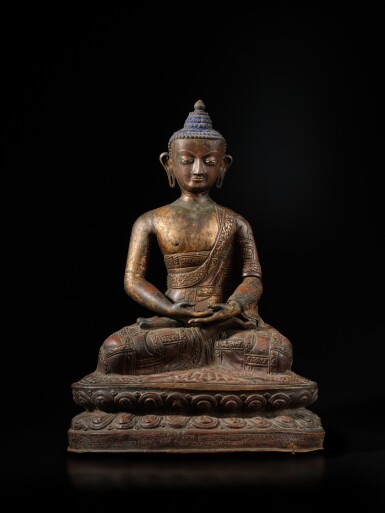Indian and Himalayan Art, including Masterpieces from the Nyingjei Lam Collection
Indian and Himalayan Art, including Masterpieces from the Nyingjei Lam Collection

A large inscribed copper-repoussé figure of Amitabha Buddha, Tibet or Nepal, circa 17th century
Auction Closed
March 21, 04:25 PM GMT
Estimate
80,000 - 100,000 USD
Lot Details
Description
A large inscribed copper-repoussé figure of Amitabha Buddha
Tibet or Nepal, circa 17th century
Himalayan Art Resources item no. 13850.
HAR編號13850
Height 18⅝ in., 47.5 cm
German Private Collection.
The repousse work on this exceptional and large sculpture of Amitabha Buddha is of high quality, with sensitive depiction of the soft facial features and precise delineation of the elaborate robes. The base is sealed, complete with an intricate visvavajra. It is rare to find a figure of this size, stature and quality. There is, however, a large figure with similar posture and treatment of the robes in the Red Temple in Tsaparang Monastery, photographed by Eugenio Ghersi in 1935. The similarity of the modeling of both sculptures suggest that this, too, was an important commission for a temple in Western Tibet, possibly created by a Newar artisan. The style of the current figure, especially the pinched face type and the raised robe edge decoration closely related to a Nepalese 17th century figure of Shakyamuni Buddha illustrated by Ulrich von Schroeder, Indo-Tibetan Bronzes, Hong Kong, 1981, pl. 103C, and a figure of Dipankara, dated to 1612, illustrated ibid., pl. 103B.
The pedestal is inscribed with a lengthy inscription composed of 11 lines, preceded and concluded by auspicious Sanskrit formulae. This dedicatory inscription allows for the identification of Buddha Amitabha. It suggests that the present image was commissioned in the context of post mortem practices following the passing of several individuals. Unfortunately, the identity of the deceased cannot be established with any degree of certainty. It includes a master named Gyüdzin Wangchen and his disciple, together with a local female ruler. Another reading might suggest that the female ruler had the Buddha Amitabha image made in order to generate merits for Gyüdzin Wangchen and his disciple. The inscription translates as:
Om svasti.
An abundance of merits come into being from the good deeds of this life,
(....)
Is the crown ornament of the bodhisattvas, Sons-of-the-Conqueror,
I pay homage to the most excellent guide Amitabha.
Not being satisfied with a glance of the unsurpassed body of the Conqueror,
The Buddhist scholar rGyud ’dzin dbang chen and his disciple,
Have gone beyond this transient world.
The lady sovereign rDo rje (…)
As a result of the merits received, having gone to the next world,
Henceforth to the western pure land of Sukhāvatī,
May they behold the Victorious One who was miraculously born in the lotus!
Ma:gala!
